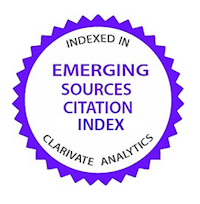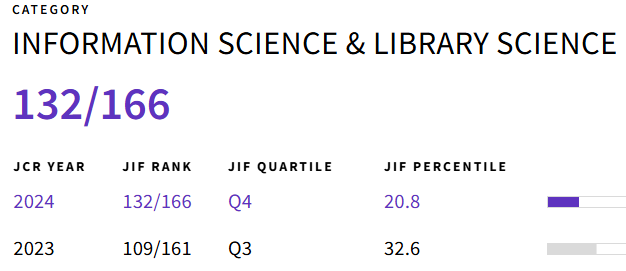Hábitos de publicación de la élite científica de España
Resumen
El objetivo de este estudio consiste en analizar los patrones de autoría y hábitos de publicación de los investigadores de España más productivos y/o citados.
Método: Se han seleccionado los investigadores españoles o que trabajan en instituciones españolas, con mayor índice H y número de citas recibidas en Google Scholar (GS) a partir del Webometrics Ranking of World Universities. Los datos de las publicaciones se han obtenido de la colección principal de Web of Science (WOS).
Resultados y conclusiones: La productividad e impacto de los investigadores en Ciencias Sociales y Humanidades es mucho menor en la base de datos WOS que en GS. Como autores hiperprolíficos destacan los investigadores en el campo de Física de Partículas, donde es habitual la publicación de 90 artículos al año firmados por más de 2000 autores. Los investigadores de Ciencias de la Salud también son altamente productivos y en multiautoría.
Descargas
Métricas
-
Resumen1012
-
PDF597
Citas
ADAMS, J.; PENDLEBURY, D; POTTER, R. y SZOMSZOR, M. Global Research Report. Multi-authorship and research analytics. Clarivate Analytics, ISI, Web of Science Group, 2019 [en línea]. Disponible en: <https://clarivate.com/webofsciencegroup/campaigns/global-research-report-multi-authorship-and-research-analysis/> [Consulta: 23 de julio de 2020]
ALLEA - All European Academies. The European code of conduct for research integrity. Berlin: ALLEA, 2017 [en línea]. Disponible en: https://doi.org/10.1142/9789814340984_0003.
ANGELL, M. Publish or perish: A proposal. Annals of Internal Medicine, 1986, vol. 104, nº 2, p. 261–262. Disponible en: https://doi.org/10.7326/0003-4819-104-2-261.
BASU, A. Using ISI’s “highly cited researchers” to obtain a country level indicator of citation excellence. Scientometrics, 2006, vol. 68, nº 3, p. 361–375. Disponible en: https://doi.org/10.1007/s11192-006-0117-x.
BIRNHOLTZ, J. What does it mean to be an author? The intersection of credit, contribution, and collaboration in science. Journal of the American Society for Information Science and Technology, 2006, vol. 57, nº 13, p. 1758–1770. Disponible en: https://doi.org/10.1002/asi.20380.
BORNMANN, L. y TEKLES, A. Productivity does not equal usefulness. Scientometrics, 2019, vol. 118, nº 2, p. 705–707. Disponible en: https://doi.org/10.1007/s11192-018-2982-5.
BRAND, A.; ALLEN, L.; ALTMAN, M.; HLAVA, M. y SCOTT, J. Beyond authorship: Attribution, contribution, collaboration, and credit. Learned Publishing, 2015, vol. 28, nº 2, p. 151–155. Disponible en: https://doi.org/10.1087/20150211.
CRONIN, B. Hyperauthorship: A postmodern perversion or evidence of a structural shift in scholarly communication practices? Journal of the American Society for Information Science and Technology, 2001, vol. 52, nº 7, p. 558–569. Disponible en: https://doi.org/10.1002/asi.1097.
CYBERMETRICS LAB. Ranking of Spanish researchers, researchers working in Spanish Institutions (Spain) and Spaniards working abroad according to their Google Scholar Citations public profiles. 15 ed., Consejo superior de Investigaciones Científicas (CSIC), 2020 [en línea]. Disponible en: <http://www.webometrics.info/en/GoogleScholar/Spain> [Consulta: 19 de julio de 2020]
ERREN, T.C.; SHAW, D. y MORFELD, P. Analyzing the publish-or-perish paradigm with game theory: The prisoner’s dilemma and a possible escape. Science and Engineering Ethics, 2016, vol. 22, nº 5, p. 1431–1446. Disponible en: https://doi.org/10.1007/s11948-015-9701-x.
FORTUNATO, S. et al. Science of science. Science, 2018, vol. 359, nº 6379, p. eaao0185. Disponible en: https://doi.org/10.1126/science.aao0185.
GÓMEZ-FERRI, J. y GONZÁLEZ-ALCAIDE, G. Patrones y estrategias en la colaboración científica: La percepción de los investigadores. Revista Española de Documentación Científica, 2018, vol. 41, nº 1, p. 1–17. Disponible en: https://doi.org/10.3989/redc.2018.1.1458.
HOLCOMBRE, A. Farewell authors, hello contributors. Nature, 2019, vol. 571, p. 147. Disponible en: https://doi.org/10.1038/d41586-019-02084-8.
HOSSEINI, M.; CONSOLI, L.; ZWART, H.A.E. y VAN DEN HOVEN, M.A. Suggestions to improve the comprehensibility of current definitions of scientific authorship for international authors. Science and Engineering Ethics, 2020, vol. 26, p. 597–617. Disponible en: https://doi.org/10.1007/s11948-019-00106-2.
HUMPHREYS, W. J. The Duty of publishing. Science, 1909, vol. 30, nº 762, p. 177–179.
INTERNATIONAL COMMITTEE OF MEDICAL JOURNAL EDITORS (ICMJE). Defining the role of authors and contributors. 2020 [en línea]. Disponible en: <http://www.icmje.org/recommendations/browse/roles-and-responsibilities/defining-the-role-of-authors-and-contributors.html> [Consulta: 12 de julio de 2020]
IOANNIDIS, J.P.A.; KLAVANS, R. y BOYACK, K.W. Thousands of scientists publish a paper every five days. Nature, 2018, vol. 561, p. 167–169. Disponible en: https://doi.org/10.1038/d41586-018-06185-8.
JONES, D.G. Is multiple authorship in conceptual bioethics ethically sustainable? American Journal of Bioethics, 2011, vol. 11, nº 10, p. 30–32. Disponible en: https://doi.org/10.1080/15265161.2011.603809.
KENNEDY, D. Multiple authors, multiple problems. Science, 2003, vol. 301, nº 5634, p. 733. Disponible en: https://doi.org/10.1126/science.301.5634.733.
KING, C. Multiauthor papers: onward and upward. Science Watch, 2012 [en línea]. Disponible en: <http://archive.sciencewatch.com/newsletter/2012/201207/multiauthor_papers/> [Consulta: 20 de junio de 2020]
KISER, G.L. No more first authors, no more last authors. Nature, 2018, vol. 561, nº 7724, p. 435. Disponible en: https://doi.org/10.1038/d41586-018-06779-2.
LANGER, N. The fundamentals that contribute to the concept of “Publish or Perish”. Educational Gerontology, 2017, vol. 43, nº 9, p. 429–430. Disponible en: https://doi.org/10.1080/03601277.2017.1332859.
LARIVIÈRE, V. y COSTAS, R. How many is too many? On the relationship between research productivity and impact. PLoS ONE, 2016, vol. 11, nº 9, p. 1–10. Disponible en: https://doi.org/10.1371/journal.pone.0162709.
LARIVIÈRE, V.; DESROCHERS, B.M.; MONGEO, P.; PAUL-HUS, A. y SUGIMOTO, C.R. Contributorship and division of labor in knowledge production. Social Studies of Science, 2016, vol. 46, nº 3, p. 417–435. Disponible en: https://doi.org/10.1177/0306312716650046.
LEEMING, J. How to manage a multi-author megapaper. Nature, 2019, vol. 575, p. S36–S37. Disponible en: https://doi.org/10.1038/d41586-019-03544-x.
MCNUTT, M.K. et al. Transparency in authors’ contributions and responsibilities to promote integrity in scientific publication. Proceedings of the National Academy of Sciences of the United States of America, 2018, vol. 115, nº 11, p. 2557–2560. Disponible en: https://doi.org/10.1073/pnas.1715374115.
MERTON, R.K. The Matthew effect in science. Science, 1968, vol. 159, nº 3810, p. 56–63. Disponible en: https://doi.org/10.1126/science.159.3810.56.
MILOJEVIC, S. Principles of scientific research team formation and evolution. Proceedings of the National Academy of Sciences of the United States of America, 2014, vol. 111, nº 11, p. 3984–3989. Disponible en: https://doi.org/10.1073/pnas.1309723111.
MUNAFO, M.R. y SMITH, G.D. Repeating experiments is not enough. Nature, 2018, vol. 553, nº 7689, p. 399–401. Disponible en: https://doi.org/10.1038/d41586-018-01023-3.
NABOUT, J.C. et al. Publish (in a group) or perish (alone): The trend from single- to multi-authorship in biological papers. Scientometrics, 2015, vol. 102, nº 1, p. 357–364. Disponible en: https://doi.org/10.1007/s11192-014-1385-5.
PAPATHEODOROU, S.I.; TRIKALINOS, T.A. y IOANNIDIS, J.P.A. Inflated numbers of authors over time have not been just due to increasing research complexity. Journal of Clinical Epidemiology, 2008, vol. 61, nº 6, p. 546–551. Disponible en: https://doi.org/10.1016/j.jclinepi.2007.07.017.
PARKER, J.N.; ALLESINA, S. y LORTIE, C.J. Characterizing a scientific elite (B): Publication and citation patterns of the most highly cited scientists in environmental science and ecology. Scientometrics, 2013, vol. 94, nº 2, p. 469–480. Disponible en: https://doi.org/10.1007/s11192-012-0859-6.
PARKER, J.N.; LORTIE, C.J. y ALLESINA, S. Characterizing a scientific elite: The social characteristics of the most highly cited scientists in environmental science and ecology. Scientometrics, 2010, vol. 85, nº 1, p. 129–143. Disponible en: https://doi.org/10.1007/s11192-010-0234-4.
RAFF, H. A suggestion for the multiple author issue. Science, 2003, vol. 302, nº 5642, p. 55–57. Disponible en: https://doi.org/10.1126/science.302.5642.55.
SHAW, D. The ICMJE’s definition of authorship is illogical and unethical. British Medical Journal, 2011, vol. 343, p. 1–2. Disponible en: https://doi.org/10.1136/bmj.d7192.
SINGH CHAWLA, D. Hyperauthorship: global projects spark surge in thousand-author papers. Nature, 2019, vol. 576, p. 342. Disponible en: https://doi.org/10.1038/d41586-019-03862-0.
SMITH, G.H. Trends in multiple authorship among papers in astronomy. Publications of the Astronomical Society of the Pacific, 2016, vol. 128, nº 970, p. 1–14. Disponible en: https://doi.org/10.1088/1538-3873/128/970/124502.
SPRINGER. Publishing ethics for journals: A guide for editors-in-chief, associate editors, and managing editors. 2013 [en línea]. Disponible en: <https://resource-cms.springernature.com/springer-cms/rest/v1/content/4252/data/v1> [Consulta: 27 de junio de 2020]
SZOMSZOR, M.; PENDLEBURY, D.A. y ADAMS, J. How much is too much? The difference between research influence and self‑citation excess. Scientometrics, 2020, vol. 123, p. 1119–1147. Disponible en: https://doi.org/10.1007/s11192-020-03417-5.
TEIXEIRA DA SILVA, J.A. y DOBRÁNSZKI, J. Multiple authorship in scientific manuscripts: Ethical challenges, ghost and guest/gift authorship, and the cultural/disciplinary perspective. Science and Engineering Ethics, 2016, vol. 22, nº 5, p. 1457–1472. Disponible en: https://doi.org/10.1007/s11948-015-9716-3.
TSCHARNTKE, T.; HOCKBERG, M.E.; RAND, T.A.; RESH, V.H. y KRAUSS, J. Author sequence and credit for contributions in multiauthored publications. PLoS Biology, 2007, vol. 5, nº 1, p. 13–14. Disponible en: https://doi.org/10.1371/journal.pbio.0050018.
WAGER, E. Are prolific authors too much of a good thing? British Medical Journal, 2015, vol. 351, p. 1-2. Disponible en: https://doi.org/10.1136/bmj.h2782.
WAGER, E.; SINGHVI, S. y KLEINERT, S. Too much of a good thing? An observational study of prolific authors. PeerJ, 2015, vol. 3, p. e1154. Disponible en: https://doi.org/10.7717/peerj.1154.
WUTCHY, S.; JONES, B.J. y UZZI, B. The increasing dominance of teams in production of knowledge. Science, 2007, vol. 316, p. 1035–1039. Disponible en: https://doi.org/10.1126/science.1136099.
Las obras que se publican en esta revista están sujetas a los siguientes términos:
1. El Servicio de Publicaciones de la Universidad de Murcia (Editum) conserva los derechos patrimoniales ('copyright') de las obras publicadas, y favorece y permite la reutilización de las mismas bajo la licencia de uso.
2. Las obras se publican en la edición electrónica de la revista bajo la licencia Creative Commons Atribución Internacional CC BY 4.0. Se puede copiar y redistribuir el material en cualquier medio o formato y remezclar, transformar y crear a partir del material para cualquier finalidad, incluso comercial.






